





This tiny white-haired woman, gentle and courageous, showed us an intriguing glimpse at the shadow world between memory and legend. Her husband Oscar Schindler became a household name as one of the great humanitarians of the century, saving 1,300 Jews from certain death in the Nazi death camps during World War II.
While Oscar Schindler's efforts to save hundreds of Jews are well known thanks to Keneally's book and the movie Schindler's List, the silver-screen version left Emilie on the sidelines. An unsung heroine. Now a new German-language book Ich, Emilie Schindler by the Argentinian author Erika Rosenberg tries to show that Emilie was just as involved in shielding Jews from the Nazis.
The biography highlights Emilie Schindler's bravery during the Holocaust and portrays her not only as a strong woman working alongside her husband but as a heroine in her own right. Erika Rosenberg, a journalist who befriended Emilie Schindler 11 years ago, is writing the book to fulfil one of the old widow's last wishes, to tell her story and to correct a historical oversight. For Emilie Schindler, the book is about finding peace. As Rosenberg says: 'She's looking for recognition. Not in the form of money, but recognition for her service .. to be the same like her husband.'
For the last five decades Emilie Schindler led a modest existence in her little house in San Vicente 40 kilometres south-west of Buenos Aires with her cats, dog and beautiful roses. Only the uniformed Argentinean police disturbed the idyll. They were posted 24 hours a day to protect the old lady from anti-Semitic and ultra-Conservative extremist groups.
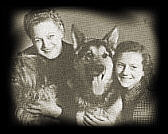
Emilie Pelzl was born on October 22, 1907, in the city of Alt Moletein, a village in the German-populated border region of what was then The Republic of Czechoslovakia. Emilie later recalled the local pastor, an old family friend, who instructed young Emilie that her friendship with a young Jew, Rita Reif, was not good. Emilie defied the pastor and retained her friendship with Rita, until Rita was murdered by the Nazis in front of her father's store in 1942.
Emilie Pelzl first saw the tall, handsome and outgoing Oscar Schindler when he came to the door of her father's farmhouse in Alt Moletein. It was 1928 and Oscar was selling electric motors. After a courtship of six weeks, they were married on March 6, 1928, in an inn on the outskirts of Zwittau, Oscar's hometown. Emilie's father had given Oscar a dowry of 100.000 Czech crowns, a considerable sum in those days, and he soon bought a luxury car and squandered the rest on outings. In her A Memoir Where Light And Shadow Meet Emilie recalls how she struggled trying to understand him:
In spite of his flaws, Oscar had a big heart and was always ready to help whoever was in need. He was affable, kind, extremely generous and charitable, but at the same time, not mature at all. He constantly lied and deceived me, and later returned feeling sorry, like a boy caught in mischief, asking to be forgiven one more time - and then we would start all over again ...
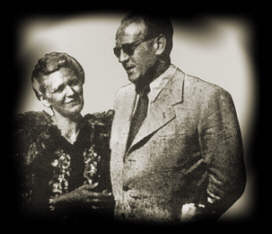
Emilie and Oscar Schindler
In the thirties, now without employment, Oscar Schindler joined the Nazi party, as did many others at that time. Maybe because he had seen possibilities which the war brought in its wake, he followed on the heels of the SS when the Germans invaded Poland.
He left Emilie in Zwittau and moved to Crakow, where he took over a Jewish family`s apartment. Bribes in the shape of money and illegal black market goods flowed copiously from Schindler and gave him control of a Jewish-owned enameled-goods factory, Deutsch Emailwaren Fabrik, close to the Jewish ghetto, where he principally employed Jewish workers. At this time presumably because they were the cheapest labour ...
But slowly as the brutality of the Nazis accelerated with murder, violence and terror, the seeds of their plan for the total extermination of the Jews dawned on Schindler in all its horror - he came to see the Jews not only as cheap labour, but also as mothers, fathers, and children, exposed to ruthless slaughter.
So with help from Emilie he decided to risk everything in desperate attempts to save the 1300 Schindler Jews from certain death in the hell of the death camps. Thanks to massive bribery and Oscar's connections, they got away with actively protecting their workers.
Schindler promised the Jews who worked for him that they would never starve, that he would protect them as best he could. And he did, building his own workers barracks on the factory grounds to help alleviate the sufferings of life in the nearby Plaszow labor camp. He gave safe haven to as many Jewish workers as possible, insisting to the occupying Nazis that they were "essential workers", a status that kept them away from harassment and killings.

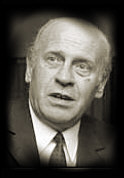
At Schindler`s factory, nobody was hit, nobody murdered, nobody sent to death camps. But conditions at the factory were far from comfortable. Freezing, lice-ridden inmates still suffered typhus and dysentery.
Until the liberation of spring, 1945, the Schindler's used all means at their disposal to ensure the safety of the Schindler-Jews. They spent every pfennig they had, and even Emilie's jewels were sold, to buy food, clothes, and medicine. They set up a secret sanatorium in the factory with medical equipment purchased on the black market. Here Emilie looked after the sick. Those who did not survive were given a fitting Jewish burial in a hidden graveyard - established and paid for by the Schindlers.
Later accounts have revealed that the Schindlers spent something like 4 million German marks keeping their Jews out of the death camps - an enormous sum of money for those times.
The factory continued to produce shells for the German Wehrmacht for 7 months. In all that time not one usable shell was produced! Not one shell passed the military quality tests. Instead, false military travel passes and ration cards were produced, just as Nazi uniforms, weapons, ammunition and hand-grenades were collected.
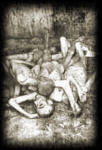
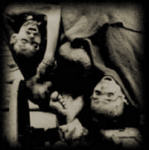

One night in the last weeks of the war a tireless Emilie, acting alone while Oscar was in Crakow, saved 250 Jews from impending death. Emilie was confronted by Nazis transporting the Jews, crowded into four wagons, from Golechau to a death camp. She succeeded in persuading the Gestapo to send these Jews to the factory camp "with regard to the continuing war industry production". In her A Memoir she recalls:
We found the railroad car bolts frozen solid .. the spectacle I saw was a nightmare almost beyond imagination. It was impossible to distinguish the men from the women: they were all so emaciated - weighing under seventy pounds most of them, they looked like skeletons. Their eyes were shining like glowing coals in the dark ..
Each had to be carried out like a carcass of frozen beef. Thirteen were dead but the others still breathed. Throughout that night and for many nights following, Emilie worked without halt on the frozen and starved skeletons. One large room in the factory was emptied for the purpose. Three more men died, but with the care, the warmth, the milk and the medicine, the others gradually rallied.
After the war survivors told about Emilie's unforgettable heroism in nursing the frozen and starved prisoners back to life ..
Emilie Schindler is credited with many acts of kindness, small and large. Even today surviving Schindler-Jews remember how Emilie worked indefatigably to secure food and somehow managed to provide the sick with extra nourishment and apples. A Jewish boy, Lew Feigenbaum, broke his eyeglasses and stopped Emilie in the factory and told her: "I broke my glasses and can't see .." When the Schindler-Jews were transferred to Brunnlitz, Emilie arranged for a prescription for the eyeglasses to be picked up in Crakow and delivered to her in Brunnlitz.
Feiwel (today Franciso) Wichter, 75, was No. 371 on Schindler's List, the only one of the Schindler Jews living in Argentina:
As long as I live, I will always have a sincere and eternal gratitude for dear Emilie. I think she triumphed over danger because of her courage, intelligence and determination to do the right and humane thing. She had immense energy and she was like a mother.
Another survivor, Maurice Markheim, No.142 on the list, later recalled:
She got a whole truck of bread from somewhere on the black market. They called me to unload it. She was talking to the SS and because of the way she turned around and talked, I could slip a loaf under my shirt. I saw she did this on purpose. A loaf of bread at that point was gold .. There is an old expression: Behind the man, there is the woman, and I believe she was the great human being.
In May, 1945, it was all over. The Russians moved into Brunnlitz. The previous evening, Schindler gathered everyone together in the factory, where he and Emilie took a deeply emotional leave of them.
The Schindlers - and 1300 Schindler-Jews along with them - had survived ....

Schindler with the Rosners
Oscar Schindler`s life after the war was a long series of failures. He tried without success to be a film producer and was deprived of his nationality immediately after the war. Threats from former Nazis meant that he felt insecure in post-war Germany, and he applied for an entry permit to the United States. This was refused as he had been a member of the Nazi party.
After this he fled to Buenos Aires in Argentina with Emilie, his mistress and a dozen Schindler Jews. The Schindlers settled down in 1949 as farmers, first raising chickens and then nutrias. They were supported financially by the Jewish organization Joint and thankful Jews, who never forgot them. But Oscar Schindler met with no success, and in 1957 he became bankrupt and travelled back alone to Germany, where he remained estranged from his wife for 17 years before he died in poverty in 1974, at the age of 66.
He never saw Emilie again ...
Emilie stayed in Argentina, where she scraped by on a small pension from Israel and a $650 a month pension from Germany. Her only relative, a niece, lived in Bavaria, Germany.
Jewish organizations have honored her for her efforts during the war. In May, 1994, Emilie Schindler received The Righteous Amongst the Nations Award - along with Miep Gies, who hid Anne Frank's family in the Netherlands and preserved her diary after the family was taken away by the Nazis.


Almost 2,000 people attended the Simon Wiesenthal Center's Yom Hashoah commemoration honoring Emilie Schindler. The tiny woman in the navy blue pantsuit was greeted with smiles and tears as she made her way, supported by two rabbis, toward the menorah-shaped monument at the Museum of Tolerance, where she lit the memorial flame to remember the 6 million Jews killed in the Holocaust. 'Let me touch you,' said one woman as she reached out to embrace Emilie Schindler.
In 1995, Argentina decorated her with the Order of May, the highest honor given to foreigners who are not heads of state. In 1998 The Argentine government decided to give her a pension of $1,000 a month until her financial situation improved. Last November, Emilie Schindler, was named an Illustrious Citizen by Argentina.

Emilie fell last Nov. 1 at her home in San Vicente. She lay for hours, alone. After undergoing a hip replacement operation, Emilie had to enter a home for the elderly in Buenos Aires, her care heavily subsidized by Argentine charities. Hospital officials had delayed her surgery for three days because she could not afford the operation. Financiel help eventually came from several soccer players, River Plate, and other Argentine citizens.
In July, 2001, during a visit to Berlin, Germany, a frail Emilie handed over documents related to her husband to a museum. Confined to a wheelchair and totally dependent upon others, she told reporters that it was her 'greatest and last wish' to spend her final years in Germany, adding that she had become increasingly homesick. 'I am very happy that I can be here,' she told with a dazzling smile.
Her Argentinian biographer Erika Rosenberg said she was urgently seeking a German home for Schindler's widow. 'Now, as an old lady, Emilie Schindler needs help herself for the first time,' Rosenberg said. The German state of Bavaria immediately offered a home to Emilie Schindler. Bavaria would be happy to help fulfill her wish, Bernhard Seidenath, a spokesman for the Ministry of Social Affairs, said Monday July 16, 2001.

Emilie Schindler - an unsung heroine
A deeply grateful Emilie accepted the offer. She will be taken Sunday July 22, 2001, to the Adalbert Founder Home in the Bavarian town of Waldkraiburg by ambulance from Berlin, said Joerg Kudlich, head of the home.
But the plans to transport her to the retirement home was put on hold as she was hospitalized in critical condition on saturday July 21. Mrs. Schindler is in intensive care, a transport is out of the question, said Dr. Hans Pech, head of interior medicine at the Maerkisch-Oderland Hospital outside Berlin.
Emilie Schindler died Friday night October 5, 2001, in the Berlin hospital.
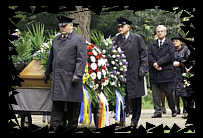

The
coffin of Emilie Schindler in the cemetery of Waldkraiburg, southern Germany,
Friday, Oct. 19, 2001, during the funeral
The famous Argentine journalist Sol tells that one of her favourites interviews was on radio with Emilie Schindler:'When I talked with her I felt a great spirit of love and wisdom in her words. She's a great woman, a woman of courage and a woman of love and compassion for others. She did much more than the movie presents.'
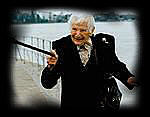

As to Oscar Schindler the author Erika Rosenberg had no doubt: 'Emilie still loved Oscar Schindler', though Emilie was bitter and disillusioned: 'He gave his Jews everything - and me, nothing.' But she was capable of expressing both her love and bitterness towards him in one sentence, calling him a drunk and womanisor, but also saying: 'If he'd stayed, I'd have looked after him.'
In A Memoir Emilie tells about her inner thoughts, when she visited his tomb, over thirty-seven years after he left:
|
"At last we meet again .. I have received no answer, my dear, I do not know why you abandoned me .. But what not even your death or my old age can change is that we are still married, this is how we are before God. I have forgiven you everything, everything .. " |


Sources:
A tale of intrigue, feuds, Hollywood tycoons - Linda Diebel, The Totonto Star
Schindler's List Teaching Guide - Southern Institute for Education and Research
Herbert Steinhouse - The Real Oskar Schindler
Rickey Rogers, Reuters News Pictures Service
Elinor
J. Brecher - Schindler's Legacy
Washington Post Foreign Service
Radio
Sol - Radio in Argentina
The Simon Wiesenthal Center
AP Photo/Diether Endlicher
Erika Rosenberg
Associated Press
Rafael Wollmann
www.auschwitz.dk www.oskarschindler.com www.shoah.dk
©
2005-2007 Louis Bülow Privacy.
All Rights Reserved.